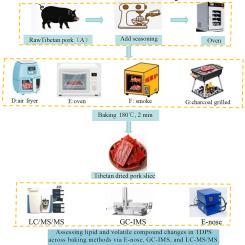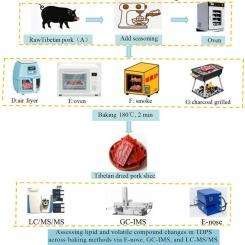Formation and lipidomic analysis of flavor substances in Tibetan dried pork slice with four different baking methods
IF 9.8
1区 农林科学
Q1 CHEMISTRY, APPLIED
引用次数: 0
Abstract
The research analyzed changes in lipids and volatile flavor substances in Tibetan dried pork slice (TDPS) under four baking methods: air fryer, oven baking, smoking and charcoal baking, using electronic nose (E-nose), gas phase ion mobility spectrometry (GC-IMS) and liquid chromatography-tandem mass spectrometry (LC-MS/MS). The study found that contents of alcohols (25.22 %), esters (42.66 %) and aldehydes (34.13 %) in raw meat were higher than that in TDPS. A total of 38 volatile flavor compounds were identified in TDPS, with alcohols (10), esters (9), ketones (8), and aldehydes (7) as primary compounds. Additionally, 780 lipids were detected, predominantly 392 Glycerolipids (GL) and 273 Glycerophospholipids (GP), triglycerides and phosphatidylcholine being the main subclasses. Phosphatidylmethanol (PMeOH) and Diacylglyceryl trimethylhomoserine (DGTS) were more abundant in raw meat and could serve as potential markers for distinguishing raw from cooked meat. Specific lipids were significantly associated with major VOCs and high temperatures promote odor formation.


研究发现,生肉中醇类(25.22 %)、酯类(42.66 %)和醛类(34.13 %)的含量高于TDPS。在TDPS中共鉴定出38种挥发性风味化合物,其中醇类(10)、酯类(9)、酮类(8)和醛类(7)为主要化合物。此外,还检测到780种脂类,主要是392种甘油脂(GL)和273种甘油磷脂(GP),甘油三酯和磷脂酰胆碱是主要亚类。磷脂酰甲醇(PMeOH)和二酰基甘油三甲基高丝氨酸(DGTS)在生肉中含量较高,可作为生肉和熟肉的潜在标记物。特定脂质与主要挥发性有机化合物显著相关,高温促进气味形成。
本文章由计算机程序翻译,如有差异,请以英文原文为准。
求助全文
约1分钟内获得全文
求助全文
来源期刊

Food Chemistry
工程技术-食品科技
CiteScore
16.30
自引率
10.20%
发文量
3130
审稿时长
122 days
期刊介绍:
Food Chemistry publishes original research papers dealing with the advancement of the chemistry and biochemistry of foods or the analytical methods/ approach used. All papers should focus on the novelty of the research carried out.
 求助内容:
求助内容: 应助结果提醒方式:
应助结果提醒方式:


